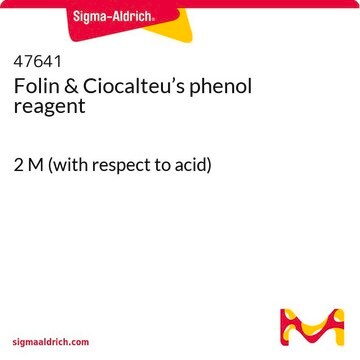If this product has an expiration or retest date, it will be shown on the Certificate of Analysis (COA, CofA). If there is no retest or expiration date listed on the product's COA, we do not have suitable stability data to determine a shelf life. For these products, the only date on the COA will be the release date; a retest, expiration, or use-by-date will not be displayed.
For all products, we recommend handling per defined conditions as printed in our product literature and website product descriptions. We recommend that products should be routinely inspected by customers to ensure they perform as expected.
For products without retest or expiration dates, our standard warranty of 1 year from the date of shipment is applicable.
For more information, please refer to the Product Dating Information document: https://www.sigmaaldrich.com/deepweb/assets/sigmaaldrich/marketing/global/documents/449/386/product-dating-information-mk.pdf
G7384
Ácido gálico
97.5-102.5% (titration)
Sinônimo(s):
Ácido 3,4,5-tri-hidroxibenzoico
Selecione um tamanho
Selecione um tamanho
About This Item
Produtos recomendados
fonte biológica
plant fruit
Nível de qualidade
Ensaio
97.5-102.5% (titration)
Formulário
powder
técnica(s)
HPLC: suitable
cor
white to beige
pf
251 °C (dec.) (lit.)
solubilidade
ethanol: 50 mg/mL, clear to slightly hazy, colorless to faintly yellow
adequação
suitable for UV spectrophotometry and general use
suitable for absorption spectrum analysis
aplicação(ões)
agriculture
metabolomics
microbiology
vitamins, nutraceuticals, and natural products
vitamins, nutraceuticals, and natural products
cadeia de caracteres SMILES
OC(=O)c1cc(O)c(O)c(O)c1
InChI
1S/C7H6O5/c8-4-1-3(7(11)12)2-5(9)6(4)10/h1-2,8-10H,(H,11,12)
chave InChI
LNTHITQWFMADLM-UHFFFAOYSA-N
Procurando produtos similares? Visita Guia de comparação de produtos
Descrição geral
Aplicação
- como padrão para quantificação de fenólicos extraíveis por calibração externa
- como padrão para determinar o conteúdo total de tanino do pó de raiz de carvalho usando o método Folin-Ciocalteu
- como ácido fenólico para estudar ′suas atividades antivirais, antibacterianas, citotóxicas e antifúngicas in vitro
Ações bioquímicas/fisiológicas
Características e benefícios
- Composto de alta qualidade adequado para várias aplicações de pesquisa
- Compatível com técnicas de HPLC e espectrometria de massa
Outras notas
Palavra indicadora
Warning
Frases de perigo
Declarações de precaução
Classificações de perigo
Eye Irrit. 2 - Skin Irrit. 2 - STOT SE 3
Órgãos-alvo
Respiratory system
Código de classe de armazenamento
11 - Combustible Solids
Classe de risco de água (WGK)
WGK 1
Ponto de fulgor (°F)
Not applicable
Ponto de fulgor (°C)
Not applicable
Equipamento de proteção individual
dust mask type N95 (US), Eyeshields, Gloves
Escolha uma das versões mais recentes:
Certificados de análise (COA)
Não está vendo a versão correta?
Se precisar de uma versão específica, você pode procurar um certificado específico pelo número do lote ou da remessa.
Já possui este produto?
Encontre a documentação dos produtos que você adquiriu recentemente na biblioteca de documentos.
Os clientes também visualizaram
Protocolos
HPLC Analysis of Polyphenols in Nero d'Avola Red Wine on Discovery® HS C18 (UV 280 nm)
Protocol for HPLC Analysis of Flavonoids on Ascentis® RP-Amide
-
How can I determine the shelf life / expiration / retest date of this product?
1 answer-
Helpful?
-
-
How is shipping temperature determined? And how is it related to the product storage temperature?
1 answer-
Products may be shipped at a different temperature than the recommended long-term storage temperature. If the product quality is sensitive to short-term exposure to conditions other than the recommended long-term storage, it will be shipped on wet or dry-ice. If the product quality is NOT affected by short-term exposure to conditions other than the recommended long-term storage, it will be shipped at ambient temperature. As shipping routes are configured for minimum transit times, shipping at ambient temperature helps control shipping costs for our customers. For more information, please refer to the Storage and Transport Conditions document: https://www.sigmaaldrich.com/deepweb/assets/sigmaaldrich/marketing/global/documents/316/622/storage-transport-conditions-mk.pdf
Helpful?
-
Active Filters
Nossa equipe de cientistas tem experiência em todas as áreas de pesquisa, incluindo Life Sciences, ciência de materiais, síntese química, cromatografia, química analítica e muitas outras.
Entre em contato com a assistência técnica









